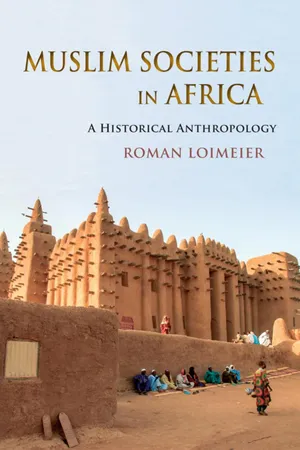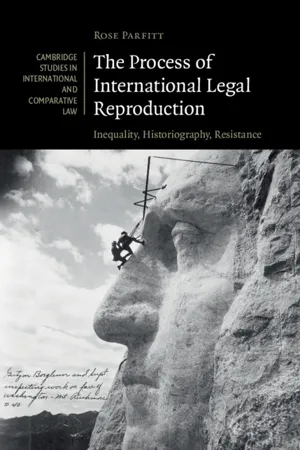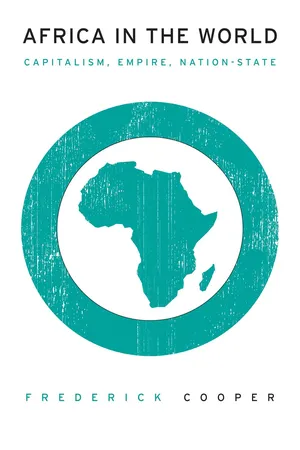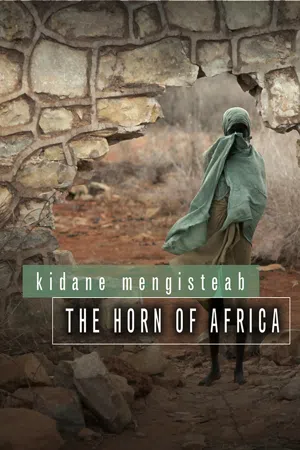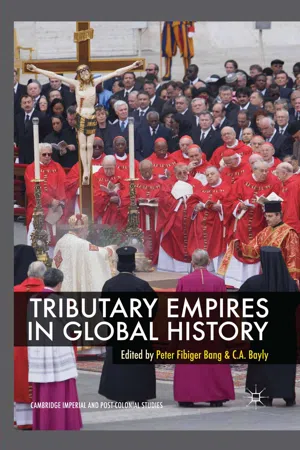History
Ethiopian Empire
The Ethiopian Empire, also known as Abyssinia, was a monarchy that existed from the 12th century until 1974. It was one of the few African countries to resist European colonization, maintaining its independence through strategic alliances and military strength. The empire's rich history is characterized by its unique blend of Christianity, indigenous traditions, and resistance to external influence.
Written by Perlego with AI-assistance
Related key terms
1 of 5
8 Key excerpts on "Ethiopian Empire"
- eBook - PDF
Muslim Societies in Africa
A Historical Anthropology
- Roman Loimeier(Author)
- 2013(Publication Date)
- Indiana University Press(Publisher)
At the same time, the struggle against external and internal enemies, in particular the Muslim emirates of the eastern highlands, dis-sident Jewish populations, and the Oromo, or, more recently, two wars against Italy, helped to forge Ethiopia’s unique character. The integrative power of imperial Ethio-pia may also explain why Ethiopia has not become a bilād al-Islām and why Christian Ethiopia has managed to retain her remarkable coherence, despite numerous crises in her history. Ethiopia from Axum to Lalibäla Pre-Christian Ethiopian history and the history of the first Ethiopian Empire and its capital city, Axum, were closely linked with the history of southern Arabia, and in many respects ancient Axum can be seen as an extension of the pre-Islamic culture of southern Arabia in northeastern Africa. Axum, in fact, was dominated by immigrant populations from southern Arabia and continued to maintain contacts across the Red Sea, not only in cultural but also in political terms. Thus, Axumite rulers intervened militarily at least twice in Yemen and seem to have controlled the Tihāma lowlands of Yemen on the Red Sea in the third century ce. In the fourth century, first Syrian Christian missionaries arrived and established Orthodox (monophysite) Christianity. However, conversion to Christianity did not affect the basic orientations of Axumite politics and Axum continued to expand in the region. Ellä Amida, the father of Ezana, who was the first Christian emperor of Axum, is credited with the conquest of Meroe on the Nile, which led to a period of Axumite domination over the lands of the Nile. Emperor Ezana is equally credited with military expeditions in both Nubia and south-ern Arabia. This expansion continued under the next emperors of Axum, in particular Ellä As ˙ beha (r. 493–535). - eBook - ePub
- Martin Plaut, Sarah Vaughan(Authors)
- 2023(Publication Date)
- Hurst Publishers(Publisher)
3 The historical reality is, of course, more complex and episodic. There is little or no historical evidence of a continuity of polity, or of royal lineage, between the period of the Axumite Empire, which seems to have ended in the seventh century CE, and the emergence of the modern Ethiopian Empire state after the mid-1850s.From the third century CE Axum emerged as a major power, controlling land to the Red Sea and trade beyond. David Phillipson situates the elusive kingdom in socio-economic developments across the northern Horn of Africa between 3,000 and 700 years ago, preceding (possibly by a gap of several centuries) two later Ethiopian dynasties:4 the Agaw Zagwe dynasty at Roha (later Lalibela, in what is now the north-east of Amhara region) from sometime after 900 CE; and a series of kings from further south, later associated with the region of Shewa (also now part of Amhara), who superseded the Zagwe in 1270 CE. The ‘Axumite civilisation’ evolved several centuries earlier, and over a much wider geographical area, than its period of ‘political hegemony’, but relatively little is known of the earlier and later phases. Much historical and archaeological work remains to be done, particularly on the later period as the empire declined. These uncertainties have made the Axumite Empire the perfect cipher onto which later nationalist histories have been projected. The conflation of the Axumite Empire with the romantic narrative of the mythical ‘Queen of Sheba’, and her legendary visit to King Solomon’s Jerusalem, further embellished later cycles of myth making.5Axum’s lucrative trade in local elephant ivory (from the lowlands north and south of the Tekeze River) helped it emerge as a significant socio-economic power during the early Roman Empire. By the second half of the third century CE, Axum had grown into a wealthy power holding sway over a growing area—although the evidence of archaeological sites, oral tradition and stone inscriptions is remarkably inconclusive. Archaeological references to the Beja (now in Sudan east of the Nile), to the Hamassien plateau around the Eritrean capital Asmara, to Adulis on the Eritrean coast, and to Simien and Welkaiyt to the south-west are plausible but not definitive.6 - eBook - PDF
The Process of International Legal Reproduction
Inequality, Historiography, Resistance
- Rose Parfitt(Author)
- 2019(Publication Date)
- Cambridge University Press(Publisher)
90 These factors also underscore, however, the way in which the ‘Aksumite’ under- standing of the Ethiopian Empire dovetailed with the Orientalist-Semiticist understanding in viewing the Empire as an entity that was, in some fun- damental way, mixed, and therefore ambivalent, unclassifiable, exceptional and, above all, legitimate in its expansionist-assimilationist impulse. 86 Paul B. Henze, Layers of Time: A History of Ethiopia (New York: C. Hurst & Co., 2000), 190, n. 8. 87 Haile Selassie I, My Life and Ethiopia’s Progress, Vol. 2 (London: Research Associates School Times, 1999), 79. 88 Marcel Griaule, ‘Comments by M. Marcel Griaule on Some of the Questions Dealt with in the Italian Government’s Memorandum on the Situation in Ethiopia’, 14 September 1935, in LNOJ (November 1935) 1588–95, at 1588. 89 See Teshale, The Making of Modern Ethiopia, 63–4. Emphasis in the original. 90 Pankhurst, An Introduction to the Economic History of Ethiopia, Vol. 1, 378. 4 THE EMERGENCE OF ETHIOPIA 241 As ‘radical left’ scholars note, Abyssinians are understood as a hybrid people in both the ‘Orientalist-Semiticist’ and ‘Aksumite’ paradigms, born of an intermingling between an extra-African (‘civilised’) element on the one hand, and an indigenous African (‘uncivilised’) element on the other. It is on this exceptionalist basis that both paradigms explain Ethiopia’s success in becoming the only polity in Africa to have escaped colonialism (apart from a five-year period of partial Italian occupation resisted tooth and nail throughout). Yet, as they also note, the Aksumite assumption that Habesha constitute a common religious community, defined against Ethiopia’s non-Christian ‘others’, obscures the degree to which Christian peasants were themselves ruthlessly exploited. - Ken Parry(Author)
- 2008(Publication Date)
- Wiley-Blackwell(Publisher)
an‘a. The events of those campaigns are recalled in the Qur’an in the story of ’Abr ə ha and the Year of the Elephant. The medieval period The history of the Ethiopian Church in the years following the waning of Aksum’s political power in the later sixth century is little known. The rise of Islam, and loss of Ethiopian control of the Red Sea coast, as well as economic factors all led the Christian kingdom to move its focus progressively further south into the Ethiopian highlands. 120 DAVID APPLEYARD Ethiopia’s relations with the nascent power of Islam are supposed by Arab historians to have been excellent. The Ethiopian kingdom was placed in Muslim tradition in the almost unique position of being a ‘land of neutrality’ or dar al-hiyad , and was not subject to attempts at conquest or conversion. This is explained by the Muslim hadith or tradi-tion that the Aksumite king offered sanctuary to Muhammad’s followers when the community was being persecuted, and by another hadith that the Aksumite king was so moved by the Prophet’s revelations that he secretly converted to Islam. Muhammad himself is said to have mourned the Ethiopian king’s death. Whatever the validity of these traditions, it is certain that Ethiopia remained Christian, unimpeded throughout the early centuries of Islam’s expansion, and continued to receive its bishops from the Coptic patriarchate of Alexandria. We know little of the spread of Christianity within Ethiopia during these years, but local traditions suggest a steady settlement by Christian families and building of churches as far south as northern Shoa, to the region where Addis Ababa now stands. This movement did not go unopposed by the indigenous pagan populations, however, and one of the most intriguing stories of this period of Ethiopian history concerns the legend of Queen Gudit (or Yodit, i.e., Judith) who led pagan resistance and destroyed the cathedral at Aksum.- eBook - PDF
Africa in the World
Capitalism, Empire, Nation-State
- Frederick Cooper(Author)
- 2014(Publication Date)
- Harvard University Press(Publisher)
Haile Selassie’s empire would outlast those of the Italians, French, and British, but it too would be caught up in the changes in the world political order and come crashing down in 1974. Here we focus on the empire in both of Du Bois’s senses—as a general political form that Africa shared with the rest of the world and as a specific form, the colonial empires constructed by Europe in Africa in the nine-teenth and twentieth centuries. 2 Putting the two together by no means diminishes the force of the indictment of colonialism. Instead, it turns the focus from the name of empire to the substance of different imperial regimes. And it takes the discussion out of a presumed narrative that leads inexorably from empire to nation-state, a pathway held to be both 40 A F R IC A IN T H E WOR L D historically correct and normative. Instead, it asks where people, at dif-ferent points in the story, actually wanted to go. In looking at the past, by freeing ourselves from the presumed normality of the nation-state form— one people, one territory, one government—we can better understand both the importance and the limitations of the political units that actually were imagined and constructed at different points of history. We can con-textualize as well the self-representations of European empire-builders as the model for progress. Empires are large, expansionist political units that preserve and repro-duce differences among the peoples and places they incorporate. In other words, empires govern different people differently. If the ruling fiction of the nation-state is homogeneity, the ruling fiction of empire is the management and exploitation of difference, and the practice of empires comes closer than that of nation-states to embodying its fiction, unboth-ered as empires are by the need to pretend they are treating subjects alike. Empires’ politics of difference took different forms. - eBook - ePub
- Kidane Mengisteab(Author)
- 2013(Publication Date)
- Polity(Publisher)
Unlike the Abyssinian empire, which was re-established by conquering other kingdoms, the Mahdiya state (1881–98) was formed by defeating an oppressive foreign rule, the Turkish–Egyptian rule. Present-day Sudan came under the Ottoman rule in 1820, when the Ottoman empire's viceroy in Egypt, Muhammad Ali, expanded the empire southwards. Mohammad Ali's troops defeated the various kingdoms in the Sudan and extended the empire into Central Africa. The Mahdiya state was established through a revolt against the Turkiya empire, which placed upon its subjects an oppressive tax system. The Mahdiya state, however, lasted less than two decades, as it fell prey to an Anglo-Egyptian colonial expedition in 1898. By contrast, the Abyssinian empire was able to maintain its independence by defeating an Italian colonization effort in 1895 in the well-known battle of Adwa.Unlike the decentralized political systems, the kingdoms and empires have left behind socioeconomic contexts that still foster inter-state and intra-state conflicts. The various wars and conquests of kingdom formation and empire-building as well as the political, economic and cultural relations that were left by the empires have left behind notable socioeconomic contexts that still have some lingering effect on nation-building. Among the specific contexts they left behind are the scars from the violence, looting and most importantly, slave raids, enslavement and slave trade. Both the Abyssinian empire and the Mahdiya state engaged in slave trade and the destructive raids involved. As Reid (2011) notes, these empires encountered endless wars of resistance from marginalized identities’ frontier regions, which often were subjected to looting and plunder. Many of the kingdoms in the region also utilized slave labour and were involved in slave trade. The Oromo kingdoms in the southern parts of Ethiopia, such as Jimma, were slave traders. Kings and nobles in Jimma and other kingdoms in the Gibe and Didessa valleys possessed estates worked by thousands of peasants and large numbers of bonded labourers. In Jima, for example, the monarch, Abba Jifar II, is said to have possessed as many as 10,000 slaves and wealthy men commonly owned more than 1,000 slaves (Fernyhough, 2010: 75). There were also some 80,000 slaves in the kingdom of Keffa in 1897 (Fernyhough, - eBook - PDF
- Peter Fibiger Bang, C. A. Bayly(Authors)
- 2016(Publication Date)
- Palgrave Macmillan(Publisher)
7 Most African political organisations known as empires are characterised by: 1. Large area 2. Centralised monarchical rule 3. Presence of a centre, which rules over many ethnic groups with different cultures, economic activities and internal political organisations 4. Successful territorial expansion Using the term empire for such extensive, multi-ethnic and expansive polit- ical organisations allows us to distinguish them from another type of African states – with a small territory and either single ethnicity, or with clear domin- ation of one ethnic group. Hence the term is useful and widely used in African studies. However, each of the features of African empires indicated above needs to be discussed and confronted with both the general and detailed definitions of empires. Unquestionably, a common feature of African empires was their large area. But the term ‘a large area’ is not precise, for the border between organisations with large and small areas is usually set in an arbitrary way. For example, in the eleventh century the spread of Ghana’s territory was about 800 kilometres on the North-South line and 1500 kilometres from the east to the west. 8 The centre of Songhay alone measured in the sixteenth century about 1200 by 800 kilometres, while the whole area of that empire, together with the peripheries, spread for about 1600 kilometres from the north to the south, and for 2400 110 Tributary Empires in Global History kilometres from the east to the west. Clearly, these political organisations had undeniably large territories. However, the Fulbe state in Masina, also termed empire, measured about 400 kilometres from the north to the south and 450 kilometres from the east to the west. Does such a territorial spread justify the use of the term empire? Congo (15–16th century), similar in size to Masina, is termed a state. - Alessandro Bausi(Author)
- 2017(Publication Date)
- Routledge(Publisher)
1 Perspectives on the History of Ethiopia 1Enrico CerulliEstablishing facts through research and the analysis of the documents and traditions is without any doubt the essential and necessary preliminary work of the historian. Thus even the account of single events that succeeded each other in time and of the action of single individuals is an important prerequisite to the writing of history. From those premises and those prerequisites, however, the historian must depart, or rather elevate himself to consider and appreciate what a particular period or a particular country - in space and time - represent in terms of value to the entire ebb and flow of human history. So today I would rather not dwell on the reconstruction of the events of Ethiopia's very rich history, nor do I propose to present you with new documents; I shall rather highlight some fundamental themes, which have driven and stimulated the history of that African country.Ethiopia is indeed African geographically, but - and I insist here on ideas that I have expressed elsewhere - it is true that the African theme has had less importance than others in Ethiopian history. This is in part a result of the physical shape of the Ethiopian plateau, projected towards Asia along the Red Sea and the Gulf of Aden and, in its central and southern part, on the contrary, precipitously overhanging the formerly unhealthy valley of the tributaries of the Middle Nile.May I add, to better clarify the contours of my argument, that here I shall not consider Ethiopia ethnically, nor discuss prehistoric and protobistorical Ethiopia, but will focus on the Ethiopian state and the causes of its formation and its early structural and cultural development.Here is a first powerful theme in Ethiopian history: the immediate proximity of the country to the Arab Peninsula and its relations with the Arabs, especially those of the South. Indeed, the first Ethiopian state sprang along the Erythraean coast, and then developed along the front spur of the plateau - I mean from Adulis, the port, to Aksum, the capital - as a consequence of the migration of southern Arabs who brought their language, their culture, their organisation and their enterprising spirit from the renowned lands of Saba to the African coast facing them.
Index pages curate the most relevant extracts from our library of academic textbooks. They’ve been created using an in-house natural language model (NLM), each adding context and meaning to key research topics.
